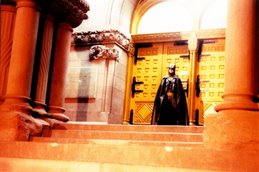If Fargo and The Howling ever shared DNA, the result might look a lot like The Wolf of Snow Hollow. Written, directed by, and starring Jim Cummings, the film is a genre-bending hybrid—equal parts murder mystery, werewolf thriller, and midlife crisis drama. Remarkably, this unlikely combination holds together with surprising cohesion.
The film follows Officer John Marshall (Jim Cummings), a tightly wound small-town cop dealing with a failing sobriety streak, anger management issues, and a father (Robert Forster) whose declining declining health has him reluctantly stepping down as Sheriff. Oh, and did I mention there’s a possible werewolf ripping through their quiet mountain town? Yeah, rough week. Despite his personal struggles—including his recent sobriety, anger management issues, and the stress of raising his teenage daughter, Jenna (Chloe East)—John is determined to prove that this is a case of human violence, not something supernatural. However, as more victims turn up, each slaughtered with an almost inhuman level of brutality, panic spreads through the town, and rumours begin circulating that the murders are the work of a werewolf.
This certainly looks like a werewolf.
And from that premise, The Wolf of Snow Hollow appears to be a conventional werewolf horror film – a small, snowy mountain town is terrorized by a series of brutal murders, with the victims appearing to be savaged by an animal. As John’s frustration grows as he battles not only the town’s fear but also his own self-destructive tendencies. His fellow officers, including Officer Julia Robson (Riki Lindhome), try to keep the case grounded in reality, but the bizarre nature of the evidence—massive paw prints at the crime scenes, victims killed on full moon nights, and a lack of solid human suspects—only fuels the legend of the “Snow Hollow Horror.” However, unlike traditional werewolf films that lean heavily into supernatural horror elements, The Wolf of Snow Hollow plays with the audience’s expectations, keeping them guessing whether the monstrous attacks are the work of a real werewolf or something far more human.
Could it be this creepy guy burning a corpse?
Stray Observations:
• John Marshall is an alcoholic police officer in a small town, as was the main character in WolfCop, is this a trope now?
•
The small town’s police officers debate whether to allow the FBI to
investigate the murder. It would not be their decision. Mulder and
Sculley would have shown up on their own.
• A mother leaves her
restaurant table to escape a creepy stranger, it seems unfathomable she
would leave her three-year-old daughter alone in his presence. Mother of
the year she is not.
• Later, that same mother exits her car to
investigate the deer carcass, she leaves her daughter unattended with a
window rolled down in a snowstorm. Please, somebody, call Child
Services.
Oh well, never mind.
The film presents itself as a werewolf mystery but ultimately functions as a character study wrapped in the guise of a horror film. With Cummings serving as writer, director, and lead actor, the film carries his signature blend of emotional intensity and dry humour, making for a viewing experience that is as entertaining as it is unsettling. And most intriguing, is the way it plays with the whole “Is it supernatural or just terrifyingly human?” It keeps you guessing, which is rare in the creature feature genre. Rather than fully committing to creature-feature horror, the film instead emphasizes the psychological unravelling of its protagonist. He’s the definition of a flawed protagonist.
“Yes, I’m an asshole. I thought everyone knew that.”
The werewolf myth clearly serves as a metaphor for John’s inner
turmoil, as he grapples with his own violent tendencies, familial
pressures, and personal failures. This approach keeps the film fresh and
unpredictable, avoiding well-worn genre tropes in favour of something
more introspective and character-driven. Think Jaws,
if Chief Brody was even more neurotic and had a failing relationship
with literally everyone. John’s emotional instability is often played
for both humour and drama. His frequent outbursts and erratic behaviour
make him an unreliable leader, yet they also highlight his deep-seated
insecurities and desperation, which his failure as a father and the
death of his own only exacerbates.
R.I.P. Robert Forster
– In one of his last roles, Forster brings a quiet, no-nonsense
gravitas to the part of John’s father that reminds you why he was one of
the best character actors in the business.
Beneath its horror trappings, The Wolf of Snow Hollow
is a film about masculinity and the struggles that come with it. John
is a man burdened by expectations—those of his father, his community,
and himself. He refuses to show vulnerability, suppresses his emotions
through aggression, and struggles to maintain control over his life. The
werewolf, in many ways, is a representation of his worst fears: losing
control, succumbing to rage, and becoming the very monster he is
hunting.
Note: Don’t expect An American Werewolf in London
level transformation scene as this film leans into the less-is-more
approach, which works… but some horror fans might feel cheated.
In conclusion, The Wolf of Snow Hollow
is an offbeat, stress-inducing, yet strangely hilarious horror mystery
with a werewolf problem… or maybe just a really angry man in a fur suit.
Either way, it’s a howling good time (pun 100% intended). If you like
your horror with a side of existential dread and awkward small-town cop
drama, this is absolutely for you. Just don’t expect John Marshall to
keep his cool—because he absolutely won’t.








No comments:
Post a Comment